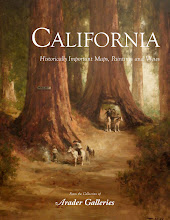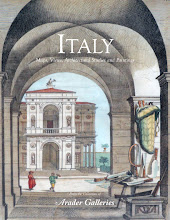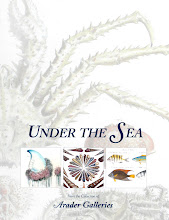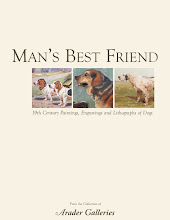Tuesday, November 24, 2009
Botanical Mezzotints by Thornton
There are many different techniques of printmaking from woodcut to aquatint, but only one style, mezzotint, allows the engraver to produce finite shades of gray and subtle details for “smoother transition between line and shade.” As the article, Made in the Shade, in the November 2009 Arts & Antiques magazine states, mezzotint is a printmaking technique developed in 1642 in the Netherlands by Ludwig von Siegen, who served as an aid to nobles of the Holy Roman Empire. In the mezzotint process, the engraver creates a very detailed and luxurious print by pressing a rocker, a chisel-like tool with evenly spaced teeth onto copper plate to create peaks and valleys. Mezzotints start black and work their way lighter through this process. When finished with the engraving, the engraver “scrapes and burnishes the surface to shape the image” bringing forth the desired image from the background. Through the use of color, the image comes alive as the ink sinks deep into the valley of the copper plates and the black of the peaks creates the lines and shadows.
The mezzotint technique traveled across Europe and became widely popular in England in the mid-eighteenth to early nineteenth centuries. It was at this time, in the late eighteen century that English physician and botanical writer Dr. Robert John Thornton began engraving and printing a series of botanical illustrations using the mezzotint technique. Assembling the finest flower painters to paint original designs for the engravings, the series, Temple of Flora, was unsurpassed as a botanical document of the Romantic era. Mezzotint was a popular engraving technique in England because it was a faster process and less expensive than line engravings and other more intensive forms of printing. Arader Galleries in San Francisco is proud to exhibit Dr. Robert John Thornton’s mezzotint engravings from the Temple of Flora.
Thornton began to indulge his lifelong love for botany in 1799 when he began the engraving and printing process for the Temple of Flora, which includes five frontispieces, portraits and allegorical compositions with thirty-two plates of flowers. As with all of his brilliantly colored plates, in The Snowdrop, the blue, orange and white flowers stand vividly in the foreground against rolling, snow covered hills behind. This whimsical landscape engraving, in excellent condition, shows the range of tone and shade that the mezzotint process brings to an image, while the coloring and background adds to the dramatic velvety effect. Arader Galleries currently has a wide selection of Dr. Robert John Thornton’s mezzotints from The Temple of Flora available. For more information, please visit www.aradersf.com or call 415.788.5115.
Friday, November 13, 2009
Envisioning the World; The First Printed Maps
Envisioning the World; The First Printed Maps, 1472-1700
October 2, 2009 – January 17, 2010 at the Sonoma County Museum
A selection of 30 of the earliest printed maps from the private collection of Henry and Holly Wendt to explore the major trends in Western intellectual history from the early Renaissance through the scientific era of the Enlightenment.
Henry Wendt describes this selection of maps in the audio guide for this exhibition as a ‘collection of stories that is the grand story of the progress of knowledge and understanding of our environment and how people understood the world’. Wendt goes on, however to point out that ‘every map serves more than one purpose’ whether it be decorative, navigational, informative, for commerce or marking the outpost of an empire.’
Envisioning the World is divided into four major chronological sections, each one associated with a pioneer in scientific concepts of the time. As one walks through the exhibition, the maps display the evolution in understanding of geography and the nature of our solar system and our place in it. The exhibition also shows innovations in printing beginning with maps printed from woodcuts and graduating to detailed copperplate engravings.
The educational opportunities offered in this exhibition are accessible for those new to the world of cartography as well as those well versed. We recommend visiting the Sonoma County Museum especially to all that are interested in cartography and world history.
Arader Galleries has a fine collection of antique maps from the 16th to the 20th centuries. For more information, visit our locations at 432 and 435 Jackson Street, or call 415.788.5115.
Thursday, November 5, 2009
The San Francisco Fall Antiques Show
 The Arader Galleries team, from left: Tim Hamilton, Stephanie Waskins and Nicole Lopez
The Arader Galleries team, from left: Tim Hamilton, Stephanie Waskins and Nicole LopezBelow: Photographs of the Arader Galleries booth:


 Andreas Cellarius celestials from the Arader Galleries collection on display in installation by Sutro Architects
Andreas Cellarius celestials from the Arader Galleries collection on display in installation by Sutro ArchitectsThe oldest continuously run antique show on the west Coast, The San Francisco Fall Antique Show, was held in the Marina at the Fort Mason Center October 29-November 1st. Arader Galleries San Francisco was pleased to participate in the show and was honored to be able to exhibit amongst the world’s premier antique dealers. Along with about 70 exhibitors, Arader Galleries debuted its impressive collection of maps, natural history and botanical engravings and lithographs from the 16th – 19th centuries, iconic images of California, the Pacific Islands and Asia as well as beautiful antique furniture, globes and more. On exhibition from Arader Galleries were some of the world’s most well renowned naturalists, cartographers and artist’s works, including John James Audubon, Dr. John Robert Thornton, Maria Sibylla Merian, Andreas Cellarius and Alexis-Hubert Jalliot.
The San Francisco Fall Antiques Show is the major fundraising event for Enterprise for High School Students, a non-profit job referral and career development agency in San Francisco. The theme of the show this year was Egyptomania: Imitation as Timeless Flattery and the lecture series for the show focused on cultural and historical artifacts and their relation to the ancient Egypt, as well as present day fascination with the culture and preservation of Egyptian life. In keeping with this theme, Arader Galleries displayed its own collection of Egyptian maps by Abraham Ortelius as well as mezzotints, engravings and lithographs of Egyptian landscape views, architecture, iconic imagery, animals and more. Arader Gallery was proud to be apart of the San Francisco Fall Antique Show and thankful for the opportunity to share and exhibit our vast collection of antiques.
Subscribe to:
Posts (Atom)















